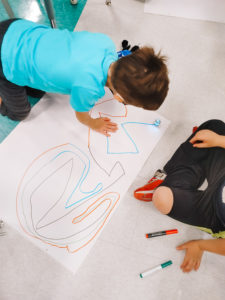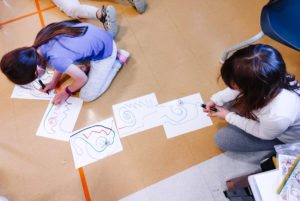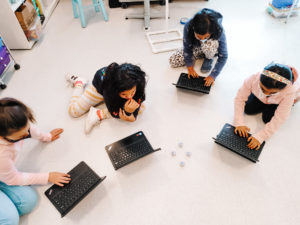There are thousands of inspiring teachers who go above and beyond for their students, and Kristen Albright, a K-5 STEM educator, is one of those special people. Impacting students daily at the State College Area School District in Pennsylvania, we are thrilled to feature Kristen as our February Educator of the Month.
With 25 years of teaching experience, her passion for teaching and STEM education knows no bounds. An Ozobot Certified Educator and recipient of the 2021 Pennsylvania Association for Educational Communications & Technology Outstanding Teacher of the Year award, Kristen’s drive and enthusiasm for computer science education is fueled by the exciting opportunities it will open up for her students in the future.
Read on to learn about Kristen’s teaching strategies during the pandemic, how she uses Ozobot to engage her students, and why she loves being a STEM educator.
On her top tech tools and key learnings from the pandemic
As a STEM teaching team, one of the positive things to come out of the pandemic was that we had the opportunity to adjust some of our activities and content for time and students’ needs. We had to look at what was really important because we had less time with the children. For instance, ‘what lessons covered the standards in multiple ways?’ By thinking with that approach, we were able to focus on student enjoyment and engagement much more. We cut out many of the written components of our lessons and went to more of an observational model with increased student choice. The result was much more streamlined projects with increased technology and opportunities for students to convey their learning in ways that were exciting for them.
We also discovered some tools that worked well both in the classroom and in remote settings. The Ozobot Simulator, powered by Ozobot Blockly, was a prime example of this. Students were able to be paired via Google Meet, one with the Evo robot in the classroom and one at home using the Ozobot Simulator. It was a way to bridge the gap between in person and at home learners. Now that we are all back in the classroom together, we still love the Ozobot Simulator. Students feel very comfortable with this platform and have made some amazing projects using it.
Another big takeaway was the need for home-school connections. We had to communicate with families much more frequently because of the pivots between in-school and remote learning. To that end, we adopted the Seesaw Learning Journal platform. It has allowed students to share their learning both with teachers and parents. Caregivers are much more informed about what their child is doing in STEM class. It has created opportunities for children to discuss their STEM learning at home. Parents can comment on their children’s posts and teachers can provide seamless feedback. This is one tool that we plan to keep moving forward because of the strong parent connections it provides.

On her favorite Ozobot projects
One of my favorite projects we did this year was one that I found in Ozobot Classroom called “The Snow Plow”. We have a third-grade unit on Transportation Engineering and students learn about traffic patterns and how vehicles can move more safely on the roadways. We live in chilly, snowy Pennsylvania, and they are certainly familiar with the snow plows that we see almost daily.
Students worked in teams to design roadways with intersections and then designed a snow plow for the front of the Ozobot Evo robot. The plows were made from just tape and index cards. Groups used foam pieces of “snow” and had to program the Ozobot to traverse the roads while plowing the snow to the sides of the road. They used the Ozobot Simulator and rulers to precisely measure the path of their Ozobot snow plow. This lesson incorporated the engineering design process, measurement, traffic safety, and communication! It was exciting to see how students challenged themselves to make the plows more effective. They even incorporated light effects such as traffic signals to enhance their projects.
This was a project that allowed me to step back and be a facilitator instead of directly instructing the entire lesson. This lesson was based on trial and error, and by collaborating with their teammate, they were able to achieve their goals. The students designed their prototypes and tested them out. They were instantly able to see what they needed to do to improve it. There were not many materials involved and each student was able to feel a measure of success. They all understood the end goal and worked together to make it happen.

On the state of CS education in Pennsylvania
Pennsylvania is really making a push for stronger computer science (CS) in schools. Our school district was fortunate to be awarded a PA Smart Grant, which included funding for professional development in CS and STEM for our team. It is a statewide initiative that includes $60 million in funding and was developed in part by the Pennsylvania Workforce Development Board to ensure that the students in Pennsylvania schools are workforce ready.
We worked together to create a scope and sequence for Computer Science in our district using SCRIPT, a comprehensive planning tool for districts, based on the CSTA standards. The grant enabled us to partner with an intermediate unit to deliver our training as an intensive bootcamp, where we learned about the foundations of CS in Schools and gained knowledge of the tools that could enhance our CS curriculum. We were able to purchase materials that would help deliver instruction.
Our school district was able to do this important work because we had the ability to access the training and materials through this grant. I would love to see all of Pennsylvania’s schools place an emphasis on CS, making it accessible for all students in our commonwealth. The PA Smart Grant is continuing to fund school districts who need to implement and improve their CS offerings in elementary school and beyond.
Why she loves being a STEM educator
My favorite part of being a STEM educator is that all my students have the opportunity to be successful. They can all see themselves as scientists and engineers! When I was young, there were not nearly as many opportunities for females to excel in the fields of science, technology, engineering, and math. Now, through programs like the one that I have the privilege to be a part of, all students have role models they can relate to in those fields. No matter what career path they choose for their future, it will be touched by STEM.
I love the enthusiasm that my K-5 learners bring to the classroom. The energy in my STEM room is contagious! When children come to my classroom, they know that it is a place of exploration and fun. Mistakes are encouraged because that is how we learn and grow. Children can be loud and messy as they make connections to the tools, curriculum, and each other. In STEM, they are learning to make sense of their world, to find out how things work, and think about how to improve things to make them work even better. They develop empathy towards their community and world, thinking globally about real-world problems and how they can work toward solutions.

Part of being a STEM educator is learning to let go of some of the control over the outcomes for projects and lessons and allow the students to drive their own learning. I am amazed at what they build and create! Projects always end up being better than I could have envisioned. When you have 25 or so creative minds in one space, there is no telling what is possible.
I am extremely fortunate to have the K-5 STEM team with me every step of the way on this journey. We developed the curriculum together four years ago for the State College Area School District as a brand new course. We have unbelievable administrative support for this endeavor. We plan our lessons and units together as a team, even though we work in different buildings, and we spend in service and summer planning times to continue to grow and improve our program. I can’t wait to see where we are as a team and as a district in 5 years!
Want to hear the latest from Kristen? Follow her on Twitter.









